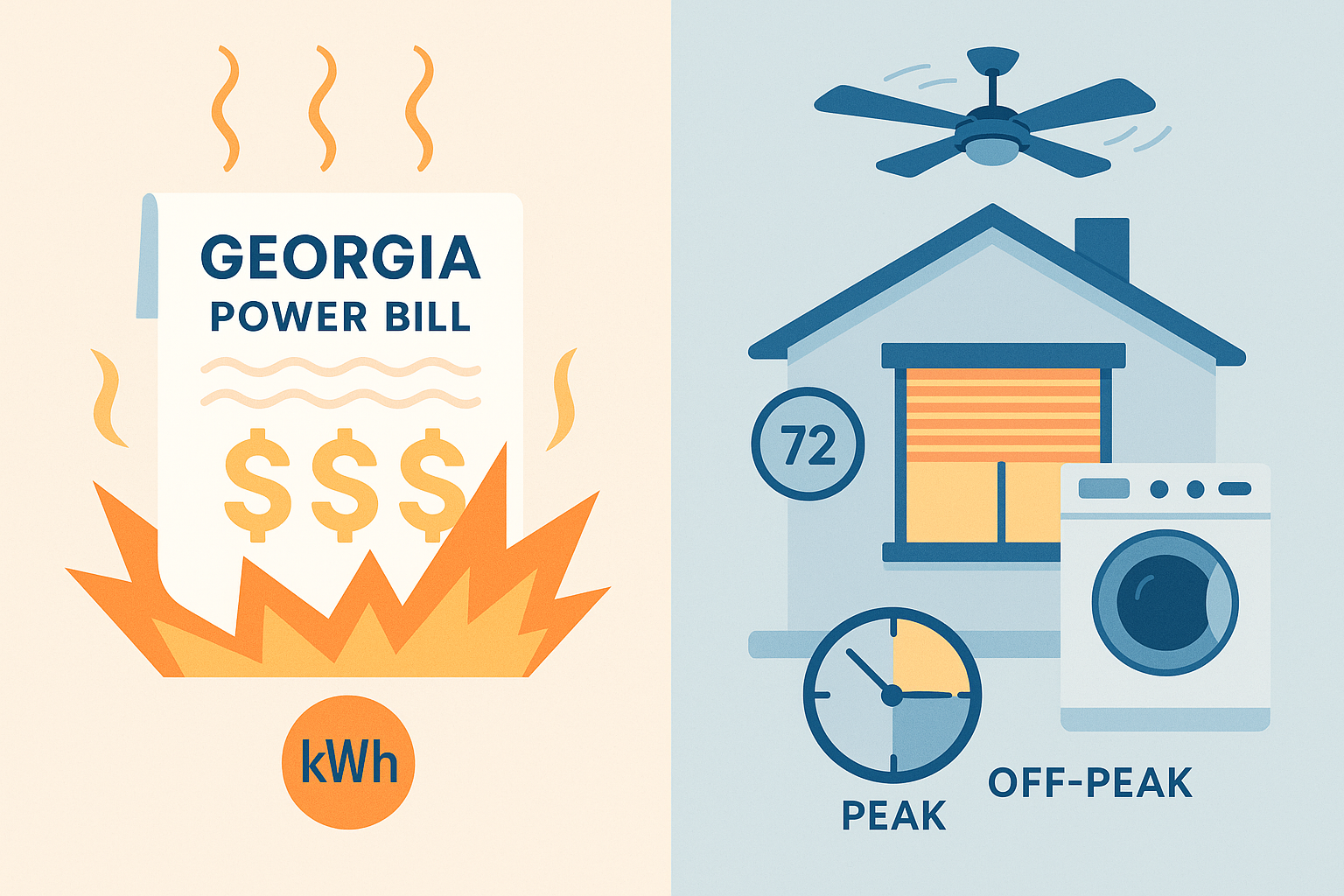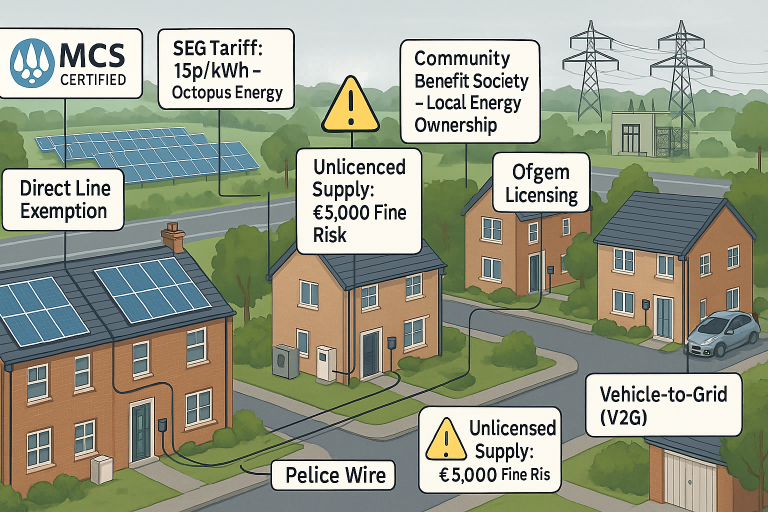Average Electricity Bill in Georgia: Tips to Save Money
If you’ve ever glanced at your monthly electricity bill and wondered where all that money went, you’re not alone. For Georgia residents, high energy costs are a familiar challenge—especially during the sweltering summer months. While the state’s electricity rates are slightly below the national average, many Georgians still end up paying more than expected.
The real issue lies in how much power households use. With long, hot summers driving near-constant air conditioning use, Georgia ranks among the top states for residential electricity consumption. Add in an aging power grid, rising infrastructure costs, and time-of-use pricing models, and it’s no wonder bills can quickly spiral out of control.
The good news? There are proven, practical ways to reduce your energy usage and lower your monthly bill—without sacrificing comfort. From thermostat adjustments and appliance scheduling to energy-efficient upgrades and incentive programs, this guide will walk you through everything you need to understand about Georgia’s electricity landscape—and how you can take control of your energy costs.
The Hard Numbers: What You Can Expect to Pay
Average Rate Per kWh:
Georgia’s average residential electricity rate is approximately 11.42¢ to 15.43¢ per kWh, depending on the provider and time of year. This places Georgia slightly below or at par with the national average of 16.44¢ per kWh.
Monthly Usage:
Georgians use significantly more electricity than the national average. While the typical U.S. household uses about 855 kWh/month, Georgia households consume between 1,035–1,457 kWh/month, primarily due to cooling needs.
Monthly & Annual Costs:
On average, a family of four living in a 2,000-square-foot home pays around $133–$218 per month, or about $1,600–$2,616 annually for electricity.
Example Calculation:
For a household using 920 kWh/month at 11.42¢/kWh, the base cost would be:
920 x 11.42 = $104.73Additional fees, taxes, and surcharges (including storm recovery fees and nuclear construction charges) increase the total to an average of $133/month under Georgia Power.
Why Are Electric Bills So High in Georgia?
Despite relatively low rates, several factors contribute to higher-than-expected bills:
1. High Summer Cooling Demand
Air conditioning accounts for nearly 46% of the average electric bill during peak months. With summer temperatures regularly exceeding 90°F and high humidity, homes rely heavily on HVAC systems.
2. Aging Infrastructure
Much of Georgia’s power grid infrastructure is decades old. Maintenance and upgrades have increased operational costs, which are passed on to consumers through various surcharges.
3. Time-of-Use Pricing
Georgia Power offers Time-of-Use (TOU) plans where electricity is significantly more expensive between 2 PM and 9 PM during peak demand hours. Running appliances during these times can dramatically increase your bill.
4. Rate Increases
In the last year alone, Georgia saw a 6.25% increase in residential electricity prices—well above the national average of 3.25%. Rising fuel costs and changes to Georgia Power’s rate structure are the main drivers.
5. Additional Fees and Charges
Residents pay extra fees such as:
- Storm Recovery Fee
- Nuclear Construction Surcharge
- Franchise Fees
- These hidden costs add up over time and are often overlooked when reviewing monthly bills.
Georgia vs. National Electricity Costs
| Metric | Georgia | U.S. Average |
|---|---|---|
| Rate per kWh | 11.42¢ – 15.43¢ | 16.44¢ |
| Monthly Usage | 1,035 – 1,457 kWh | ~855 kWh |
| Monthly Bill | $133 – $218 | ~$140 |
| Annual Household Cost | ~$1,600 – $2,616 | ~$1,680 |
While Georgia has lower rates, its above-average usage pushes annual costs close to or even beyond the national average.
Top 5 Cheapest vs. Most Expensive States for Electricity
| Cheapest States | Rate (¢/kWh) | Most Expensive States | Rate (¢/kWh) |
|---|---|---|---|
| North Dakota | 11.69 | Hawaii | 43.01 |
| Idaho | 11.89 | California | 31.77 |
| Nebraska | 13.10 | Connecticut | 32.28 |
| Oklahoma | 13.30 | Massachusetts | 30.65 |
| Washington | 13.03 | Rhode Island | 28.89 |
Georgia falls somewhere in the middle but remains competitive in terms of base rates.
Who Provides Electricity in Georgia?
The primary providers include:
- Georgia Power – Largest provider, serving over 2.5 million customers.
- Oglethorpe Power Corporation – Supplies wholesale energy to 38 EMCs, covering over 4.1 million customers.
- Gray Services EMC – Serves rural areas across 10 counties.
- Jackson EMC – Provides service to over 80,000 customers in northeast Georgia.
Each utility may offer different rates and incentives, so it’s worth comparing providers if available in your area.
Science-Backed Strategies to Slash Your Bill
1. Optimize Thermostat Settings
Set your thermostat to 78°F when home and raise it 7–10°F when away or asleep. Each degree above 78°F can save 3–4% on cooling costs. Consider installing a programmable thermostat for automated savings (up to 15%).
2. Maintain Your AC System
Replace filters monthly—dirty filters can increase energy use by 5–15%. Clean coils and fins annually and schedule professional maintenance twice a year.
3. Use Fans and Ventilation Strategically
Ceiling fans create a wind-chill effect, allowing you to raise the thermostat 4°F without discomfort. Close blinds during peak sunlight to reduce heat gain.
4. Shift Usage to Off-Peak Hours
Run dishwashers, washing machines, and dryers before 4 PM or after 9 PM (June–September). Avoid using large appliances during peak hours to avoid higher TOU pricing.
5. Upgrade to Energy-Efficient Technology
Switch to LED bulbs, which use 75% less energy than incandescents and can save $75/year. Install smart power strips to eliminate phantom loads and reduce waste by 5–10%.
6. Reduce Water Heating Costs
Lower your water heater temperature to 120°F (saves 4–22% annually). Use cold water for laundry and install low-flow showerheads to cut water use by 2,700 gallons/year.
7. Invest in Long-Term Efficiency
Proper insulation prevents cool air leakage, reducing HVAC workload. Consider installing solar panels—a 12.1 kW system can offset 100% of usage, with a 12-year payback period and $62,000 in savings over 20 years.
Georgia-Specific Rebates and Programs
Georgia Power Rebates:
- Smart thermostats
- Insulation upgrades
- ENERGY STAR® appliances
- Efficient HVAC systems
Free Home Energy Audits:
Utilities like Georgia Power offer free assessments to identify inefficiencies and recommend improvements.
Time-of-Use Plans:
Enroll in off-peak rate programs to benefit from lower prices during non-peak hours.
Budget Billing:
Spread out your payments evenly over 12 months instead of facing seasonal spikes.
E-Bill & Direct Debit Discounts:
Save up to 5% with paperless billing and 2% with automatic payments.
Additional Ways to Save
- Unplug Unused Appliances: Many devices draw power even when not in use.
- Utilize Natural Light: Open windows during the day and close them at night to manage indoor temperatures.
- Energy Monitoring Tools: Track your usage online through your utility portal and set goals to reduce consumption.
Final Thoughts: Take Control of Your Energy Costs
Georgia’s electricity rates may be among the lowest in the country, but high usage—especially during summer—can lead to unexpectedly large bills. By adopting smarter habits, investing in efficiency upgrades, and taking advantage of rebates and incentive programs, you can significantly reduce your energy costs.
Even small changes—like adjusting your thermostat by a few degrees or switching to LED lighting—can add up to hundreds in annual savings. For long-term impact, consider solar energy solutions or participating in Georgia Power’s budget billing and TOU plans.
With careful planning and mindful energy use, Georgia residents can enjoy both comfort and control over their monthly electric bills.




